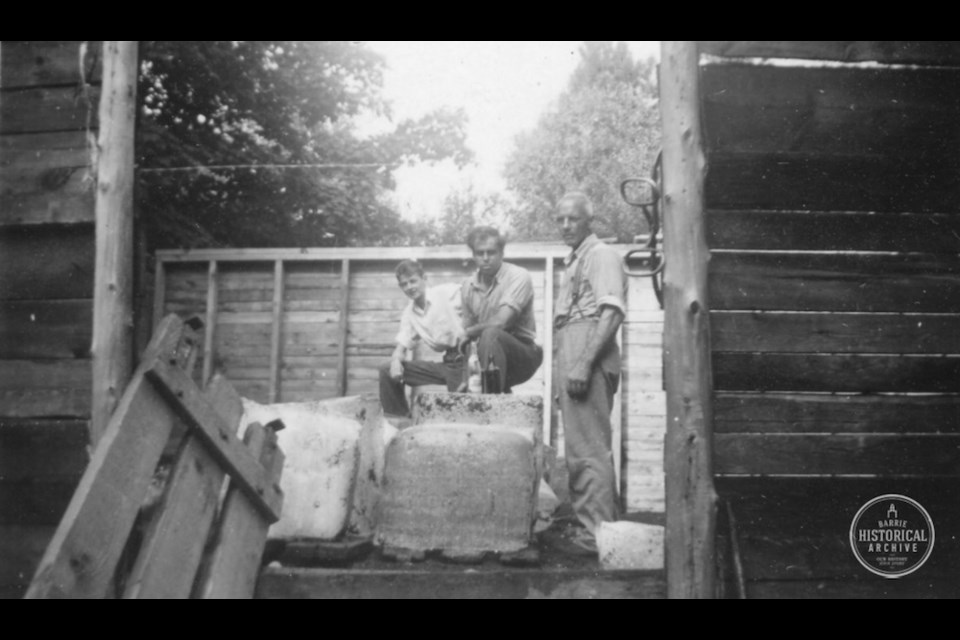That last cold blast of winter was pretty extreme. I am not a fan of these kinds of deep freeze conditions, and I must admit that I pretty much hid out in my house and wished for spring. Some Canadian I am!
I can tell you about a bunch of hardy Canucks who would have been beyond thrilled with this type of weather – the ice men. Before electric refrigerators and freezers were in vogue, these were the guys who ventured out onto windswept lakes to harvest the ice that preserved your food, and cooled your drinks, well into the summer. Not a job I would want.
By early January, they were getting eager to start up. You can almost feel the excitement in this short Northern Advance article from Jan. 12, 1922.
“Several ice companies have started to cut ice on Lake Couchiching near Orillia. The ice is fifteen inches thick and of excellent quality. On Lake Simcoe, which is larger, the ice is over eight inches thick and operations will start soon if cold weather continues. A large amount of ice will be taken from Lake Simcoe this winter and this will give employment to a number of men.”
One thing that Lake Simcoe had going for it was its reputation as the purest ice that could be purchased. It was in demand all over Ontario and even into some American states. In 1880, it was reported that the Northern Railway had a contract to deliver 300 tons of Kempenfelt Bay ice to the city of Cincinnati, Ohio.
All along the bay, near the railroad tracks, were huge wooden ice houses. Into these warehouses were placed many tons of ice cut from Kempenfelt Bay, some of it taken away by rail car, and some of it stored long after winter had ended, insulated by a thick layer of sawdust.
The ice men kept the bay clear of snow as much as they could, as the snow hampered the growth of the ice. When the ice was just right, perhaps two feet thick, it was marked into blocks measuring 22 inches by 32 inches. In the early days, horse-drawn ice plows cut the first length of ice away and pulled it out of the water where it was hand-sawn into blocks. The rest of the ice was floated along the channel created by the removal of the first section.
The real work began when the ice blocks, some weighing up to 500 pounds, had to be moved for storage or transport. This was the job of men and horses at first, but soon steam powered conveyors and ice cutters came into use.
This was big business around the lakeshore. Anywhere that there was an accessible railway depot, such as Barrie, Allandale, Orillia, Gilford, Bell Ewart and Jackson’s Point, the ice industry was a huge deal every winter. It kept seasonal employees, like farm workers, working and earning a pay cheque just about year-round.
It was the source of some big money too for the operators of these ice cutting companies. The industry was also a huge gamble, as you can imagine, as it was dependant on nature to deliver the ideal conditions. Fortunes were made in good years, and losses were heavy when spring decided to arrive too soon.
The Northern Advance of June 12, 1890 reported on the tragic tale of one ice speculator who rolled the dice and lost. Emile Messing, of Tonawanda, N.Y., bought the entire ice stock of Barrie-based Hammill and Davidson for $14,000. Soon after, Messing was offered $5,000 for the ice by someone else, but refused. As the weather warmed, the ice house began to sink and John Morrison, the Barrie man in charge of the building, telegraphed Messing several times to ask for instructions. In the meantime, the eastern wall of the building gave way and all of the ice was lost. Mr. Messing could not bear the loss.
“The other day, three business men from that place (Tonawanda) arrived and saw Morrison and Messrs. Hammill and Davidson and told them that Messing had taken the matter so hard that he took his own life by shooting himself Friday night. It appears that these three men had lent him the money. One of them is a brother-in-law and they say he evidently understood that the ice was completely destroyed and rather than meet them he committed the rash deed.”
The beginning of the end for lake ice cutting was the advent of artificial ice production. Plenty of purists held out for a while, claiming that natural ice was superior, but a few bad seasons convinced them to abandon the yearly uncertainty. The big lake ice industry was largely history by the end of the 1940s.
Each week, the Barrie Historical Archive provides BarrieToday readers with a glimpse of the city’s past. This unique column features photos and stories from years gone by and is sure to appeal to the historian in each of us.



